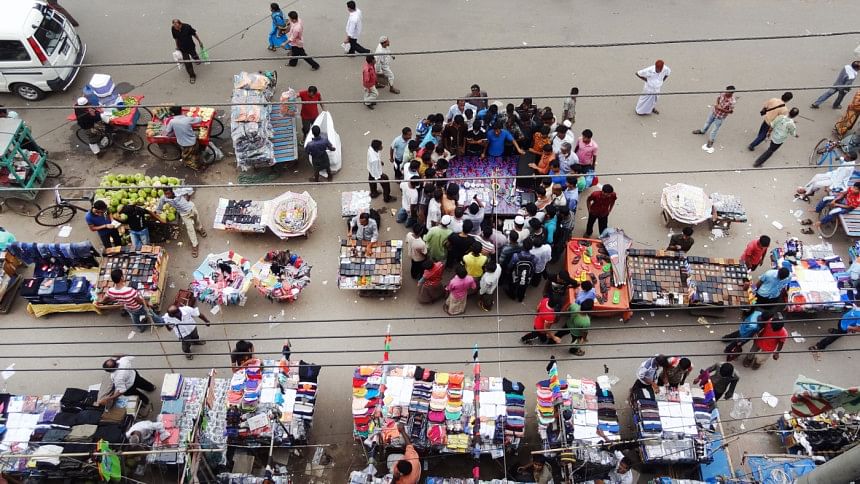Why not a national footpath policy?

Population density in cities like Dhaka and Chattogram is daunting. According to the World Bank data, Dhaka's population density per square kilometre is above 45,000, which is the densest in the world. How does this ultra-dense human mass manage to move about the city?
In the absence of a comprehensive, affordable, and efficient mass transportation system, and for a host of other positive and negative reasons, a lot of urban people rely on walking to commute to work. Research shows that within the Dhaka City Corporation (DCC) area, 19 percent of primary trips are made on foot, whereas in the greater Dhaka Metropolitan Area (excluding DCC), it is 37.2 percent.
While this daily share of commute by walking is encouraging and should be welcomed—because urban-liveability advocates across the world are championing walkability as the foundation of a healthy and carbon-neutral urban lifestyle—it should not be interpreted as Dhaka streets' success in pedestrian-friendliness. Despite poor footpath conditions, people walk because they have no other options available to them. Pedestrians are the most vulnerable urban group in this metropolis. They are survivors in city streets ravaged by air pollution, noise pollution, open drains, occupied footpaths, overflowing dumpsters, threatening buses and motorbikes, and, in general, an unpleasant pedestrian environment.
In fact, Dhaka's footpaths are not only at the epicentre of the capital's urban challenges but also cause many of them. With the exception of some affluent areas and the Parliament zone, footpaths are mostly "anti-pedestrian" (same in Chattogram), as they typically turn into wild frontiers of "informal" economies and all types of clandestine encroachment. Footpaths are occupied by vendors and tea stalls, makeshift shops and construction sites, and a host of other malpractices. Footpaths sometimes simply don't exist along roads or are dangerously interrupted by open drains, traps for orthopaedic journeys to hospitals. Sometimes they are too high and unfriendly to people with disabilities. Under current conditions, footpaths in Dhaka and other cities are unlikely to foster a positive pedestrian culture.
In short, footpaths in Bangladesh are an uncertain and arbitrary urban affair. Bangladesh needs a national footpath policy. The foundation of this policy could be as simple as this: if there is a road, there is a footpath. All kinds of urban planning—from the metropolis to small towns—should vigorously focus on footpath design. This has to be an urban requirement by law.
However, there is one caveat. We should not forget that footpaths in this part of the world are conceived differently than sidewalks in western metropolises. The "local tradition" of the coexistence of pedestrians and vendors (the significance of "informal" economy on the street can't be overlooked) has to be integrated into the footpath design.
Creating a national footpath policy will help make Bangladeshi cities efficient, pedestrian-friendly, people-oriented, carbon-restricting, business-friendly, attractive to investors, healthy, and less reliant on motorised vehicles. Over the summer this year, I often walked through cities across Bangladesh as a way to understand the general state of footpaths in the country. My realisation: pedestrians are found aplenty on city streets but they are an exceedingly fragile species. Reason: footpaths are the most neglected, under-designed, and underfunded urban infrastructure. They are like the poor, needy relative that nobody wants to encounter. And, they apparently don't offer the visual glamour of flyovers, nor could they be showcased as uber-emblems of national development.
In Dhaka, there is no single agency in charge of designing, maintaining, and improving city footpaths. However, there are 13 agencies within five ministries that have fragmented responsibilities toward pedestrian environment.
Today, around the world, footpaths/sidewalks are enjoying an urban renaissance as the foundation of walkable urbanism. "Walkability Studies" is a growing sub-field in urban planning. The other day, I was reading urban planner Jeff Speck's Walkable City: How Downtown Can Save America, One Step at a Time (2012). Speck offers a "General Theory of Walkability," which explains how a walk must meet four essential goals: usefulness, safety, comfort, and interesting. When a walk satisfies these conditions, a pedestrian can highly rate a city's walkability score.
"Usefulness" implies a kind of urban organisation in which a walker can reach his or her daily destinations by walking. "Safety" suggests that a pedestrian can both walk without being hit by a car and feel safe. "Comfort" means that the organisation of footpaths and adjacent buildings should be undertaken at a scale that the pedestrian finds welcoming. And, "interesting" is when the pedestrian finds the footpath not only walkable but also full of exciting experiences, including views of unique buildings, sites, trees, and water, and, in general, humanity. Interesting derives from what the acclaimed American journalist, urbanist, and activist Jane Jacobs memorably called "sidewalk ballet." (Jacobs is the author of the classic, The Death and Life of Great American Cities, 1961) From Jacobs, urban planners learned the virtues of planning from below or, in many ways, from the footpath.
This is not to say that footpaths are only about safety and aesthetic pleasure. It is also about business-friendliness and environmental wellbeing. Speck writes: "We must understand that the walkable city is not just a nice, idealistic notion. Rather, it is a simple, practical-minded solution to a host of complex problems that we face as a society, problems that daily undermine our nation's economic competitiveness, public welfare, and environmental sustainability."
Why are footpaths neglected in our urban vision? According to the Danish architect and urban planner Jan Gehl (who visited Bangladesh with much interest), it is a problem of the level from which city administrators and planners look down on the city. Gehl argues that they only see the "big story"—the mega-scale of the city viewable only from above and then the "medium story" of land-use plans, Detailed Area Plan (DAP), and infrastructures. But they often fail or are reluctant to see the "little story," experienced only at the ground level or at human scale. Yet, most people live their lives at the level of little stories. This is where their houses, neighbourhood parks and markets, and footpaths are. These are the places where the community flourishes.
But, alas, these little stories apparently offer neither the political capital of infrastructures, nor instant economic benefits. But the time has come for a change of mindset. All stories—big, medium, and little—are important. But sometimes little stories require extra attention, sensitivity, and care because their impact on the ground, on the public, has much more potential to create long-term sustainability. The social, environmental, economic, and health benefits of footpaths, for instance, can't be overestimated. Bangladesh is in need of a national footpath policy. But making this prudent policy will be possible only when we graduate to the next generation of urban thinking in which little stories and their everyday infrastructures matter the most.
Adnan Zillur Morshed, PhD, is an architect, architectural historian, and urbanist. He teaches in Washington, and serves as executive director of the Centre of Inclusive Architecture and Urbanism at BRAC University. He is an alumnus of Faujdarhat Cadet College, BUET, and MIT. Email: [email protected]

 For all latest news, follow The Daily Star's Google News channel.
For all latest news, follow The Daily Star's Google News channel. 



Comments